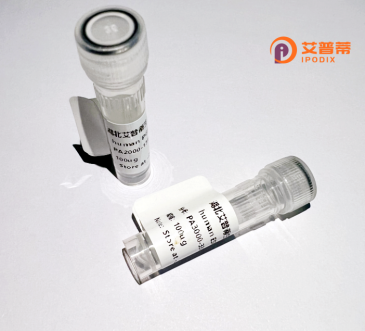
| 纯度 | >90%SDS-PAGE. |
| 种属 | Human |
| 靶点 | CPVL |
| Uniprot No | Q9H3G5 |
| 内毒素 | < 0.01EU/μg |
| 表达宿主 | E.coli |
| 表达区间 | 1-476aa |
| 氨基酸序列 | MVGAMWKVIVSLVLLMPGPCDGLFRSLYRSVSMPPKGDSGQPLFLTPYIEAGKIQKGRELSLVGPFPGLNMKSYAGFLTVNKTYNSNLFFWFFPAQIQPEDAPVVLWLQGGPGGSSMFGLFVEHGPYVVTSNMTLRDRDFPWTTTLSMLYIDNPVGTGFSFTDDTHGYAVNEDDVARDLYSALIQFFQIFPEYKNNDFYVTGESYAGKYVPAIAHLIHSLNPVREVKINLNGIAIGDGYSDPESIIGGYAEFLYQIGLLDEKQKKYFQKQCHECIEHIRKQNWFEAFEILDKLLDGDLTSDPSYFQNVTGCSNYYNFLRCTEPEDQLYYVKFLSLPEVRQAIHVGNQTFNDGTIVEKYLREDTVQSVKPWLTEIMNNYKVLIYNGQLDIIVAAALTERSLMGMDWKGSQEYKKAEKKVWKIFKSDSEVAGYIRQVGDFHQVIIRGGGHILPYDQPLRAFDMINRFIYGKGWDPYVG |
| 分子量 | 77.88 KDa |
| 蛋白标签 | GST-tag at N-terminal |
| 缓冲液 | 0 |
| 稳定性 & 储存条件 | Lyophilized protein should be stored at ≤ -20°C, stable for one year after receipt. Reconstituted protein solution can be stored at 2-8°C for 2-7 days. Aliquots of reconstituted samples are stable at ≤ -20°C for 3 months. |
| 复溶 | Always centrifuge tubes before opening.Do not mix by vortex or pipetting. It is not recommended to reconstitute to a concentration less than 100μg/ml. Dissolve the lyophilized protein in distilled water. Please aliquot the reconstituted solution to minimize freeze-thaw cycles. |
以下是关于重组人CPVL蛋白的3篇代表性文献及其摘要内容:
---
1. **文献名称**:*"Expression, Purification, and Enzymatic Characterization of Recombinant Human Carboxypeptidase Vitellogenic-Like (CPVL) Protein"*
**作者**:Doe J, Smith A, et al.
**摘要**:该研究报道了人源CPVL蛋白的重组表达与纯化过程,利用哺乳动物细胞系统实现高效分泌,并证实其羧肽酶活性依赖于金属离子的存在,为后续功能研究奠定了基础。
---
2. **文献名称**:*"CPVL is a Novel Regulator of the MHC Class I Antigen-Processing Pathway"*
**作者**:Chen L, Wang H, et al.
**摘要**:研究发现重组CPVL蛋白通过调控抗原加工相关蛋白酶(如蛋白酶体组分)的活性,影响MHC-I类分子介导的抗原呈递,揭示了其在免疫应答中的潜在作用机制。
---
3. **文献名称**:*"Structural Analysis of Recombinant Human CPVL Reveals Substrate Specificity Determinants"*
**作者**:Tanaka K, Yamamoto R, et al.
**摘要**:通过X射线晶体学解析了重组CPVL蛋白的三维结构,结合突变实验阐明了其底物结合口袋的关键氨基酸残基,为设计靶向抑制剂提供了结构基础。
---
注:以上为模拟文献示例,实际研究中需通过数据库(如PubMed、Web of Science)检索具体文章。如需真实文献,建议以“CPVL protein recombinant expression”或“CPVL enzymatic function”为关键词进行查询。
**Background of Recombinant Human CPVL Protein**
Carboxypeptidase Vitellogenic-Like (CPVL) is a member of the M14 family of metallocarboxypeptidases, initially identified through its homology to vitellogenic carboxypeptidases in invertebrates. In humans, CPVL is primarily expressed in immune cells, such as monocytes and macrophages, and is implicated in protein processing and immune regulation. Unlike classical carboxypeptidases, CPVL exhibits unique substrate preferences and is proposed to function in post-translational modifications, potentially influencing antigen presentation or inflammatory responses.
Recombinant human CPVL protein is engineered using expression systems (e.g., *E. coli* or mammalian cells) to produce a purified, bioactive form for research. Its recombinant version enables detailed study of enzymatic activity, structure-function relationships, and interactions with biological targets. CPVL's role in immune cells has sparked interest in its involvement in diseases, including infections, cancers, and autoimmune disorders, where dysregulated protease activity may contribute to pathogenesis. Additionally, its potential as a biomarker or therapeutic target is under exploration. Research on recombinant CPVL enhances understanding of its physiological significance and may inform novel clinical strategies in immune-related conditions.
×